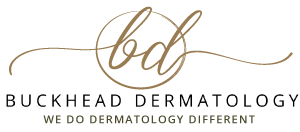What are Spider Veins?
Commonly found on the legs and face, spider veins are clusters of blue, red or purple veins near the surface of the skin. They are called spider veins because they often form clusters that often take on a spider-web-like appearance. However, spider veins can also develop as short lines that do not create a cluster with other veins. They are usually flat or slightly raised. Spider veins can develop anywhere on the body and at any age.
Spider veins are rarely dangerous but can cause some mild discomfort in some people. Treatment is usually sought for cosmetic reasons or to alleviate aching, pain or fatigue. There are a variety of treatments available for spider veins. A dermatologist will consider the extent of the spider veins, the age, and health of the patient and the family health history before recommending treatment.
If you have spider veins that are unsightly or painful, schedule a consultation with the Atlanta dermatologist at Buckhead Dermatology. Our doctor has successfully treated Atlanta residents with spider veins for over 25 years. Our expertise and commitment to getting patients the results they desire are what makes us one of the most trusted dermatologists in the Atlanta area.
Causes of Spider Veins
Spider veins are a type of venous disease. Veins have small valves that push the blood toward the heart, preventing it from flowing backward. In some people, the valves become weak and blood begins to flow back and pool in the vein. The additional blood in the vein causes pressure to build and can result in bulging or clustered veins.
Some factors give people a higher risk of getting spider veins. Some of these factors may explain why more women than men have spider veins or varicose veins. Some of the common risk factors for spider veins include:
- Aging
- Pregnancy
- Trauma or injury
- Sun exposure or damage
- Family history of spider veins
- Weight gain or being overweight
- Extended periods of sitting or standing
- Increased pressure in the face from childbirth, vomiting or coughing
- Hormonal changes from oral contraceptives or hormone replacement treatments
Are spider veins the same as varicose veins?
Although both spider veins and varicose veins are the results of weakened valves in the veins, they differ in physical appearance and symptoms. Spider veins are typically flat and red, blue or purple. Although the clusters can grow quite large, spider veins usually do not cause pain.
Varicose veins are raised, bumpy and have a knotted appearance. They can be flesh-colored, red, green, purple or blue. Varicose veins can cause discomfort, swelling and aching in the legs, especially during extended periods of walking, standing or sitting. People who have varicose veins may be at a higher risk of developing clots or other circulation problems.
Spider Vein Treatment
Most patients seek treatment for cosmetic reasons. Your dermatologist will help you understand your options and choose the best treatment for your situation and goals. Some of the most common treatments include:
- Compression Stockings: Tight socks or stockings that can cover up to the waist, compression socks increase pressure on the veins in the legs and promote better circulation. Compression socks or stockings can reduce swelling and prevent spider and varicose veins.
- Sclerotherapy: The most common treatment for spider veins, sclerotherapy involves a chemical injection directly into the vein. The chemical causes the treated vein to swell and form a blood clot, sealing it off and eventually causing it to be absorbed by the body. It may take up to six weeks and several treatments for the spider veins to entirely disappear. There is little to no downtime, and immediate walking is encouraged to prevent the formation of blood clots.
- Laser Treatments: Laser treatments send light directly into the vein. Unlike sclerotherapy, laser treatments are non-invasive. The light enters the vein, heating it and causing a blood clot. The clot is absorbed into the body through its natural healing mechanisms. Small spider veins may disappear immediately. Larger veins may take up to three months to fade and require several treatments.
Prevention of Spider Veins
Although some risk factors cannot be avoided, there are many at-home treatments and lifestyle changes that can prevent spider veins from forming or getting worse. Your dermatologist may suggest the following tips if you develop or are prone to spider veins:
- Regular exercise to maintain a healthy weight and improve circulation
- Limit the frequency of hot baths, hot tubs or saunas
- Avoid standing for more than 30 minutes at a time
- Avoid sitting for more than 30 minutes at a time
- Elevate your legs when sitting
- Avoid wearing tight clothing
- Wear sunscreen every day
- Wear compression socks
